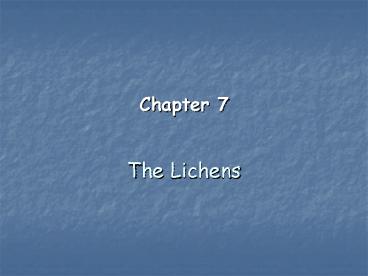The Lichens - PowerPoint PPT Presentation
1 / 35
Title:
The Lichens
Description:
From sea level to 7000 m on Mt. Everest. Biology 4223 The Fungi ... Then agal cell permits' fungus to attach to it. Biology 4223 The Fungi. Lichen Synthesis ... – PowerPoint PPT presentation
Number of Views:997
Avg rating:3.0/5.0
Title: The Lichens
1
Chapter 7
- The Lichens
2
Habitats
- Range
- Bare rock
- Extremes of temperature
- High desiccation
- From sea level to 7000 m on Mt. Everest
3
Habitats
- Bare rock
- Surface of ground
4
Lichens
- On leaves
- On ground
5
Habitats
- Intertidal zone
- Beneath rock surfaces in Namib Desert in South
Africa - Require clean air
6
Lichen Anatomy
- What is a lichen?
- It is not an organism in the normal sense
- It is a dual organism, a symbiont
- Symbiosis between fungi and algae
- Mycobiont the fungal symbiont
- Phycobiont the algal component
7
Lichen Anatomy
- Mycobiont
- Abosrbs water and minerals from substrate
- Builds complex thallus (undifferentiated body)
8
Lichen Anatomy
- Upper and lower surfaces
- Densely aggregated fungal hyphae
- Round algal cells just beneath upper cortex each
surrounded by fungal hyphae - Fungi have captured algae
- Balanced parasitism
- 50 algal food extracted by hyphae
9
Lichen Anatomy
- Mycobiont
- Phycobiont
- Mycobiont
10
Lichen Taxonomy
- Phycobiont
- Genera
- 25 eukaryotic genera of algae
- 15 prokaryotic cyanobacteria
- 80 lichens contain unicellular
- 10 filamentous green algae
- 10 cyanobacteria
11
Lichen Taxonomy
- Phycobiont
- Unicellular alga, Chlorophyta
- Trebouxia sp. (below, L) Nostoc (below. R)
- Trebouxia
12
Lichen Taxonomy
- Taxonomy
- Taxonomy based upon the mycobiont
- Names are fungal names
- Foods
- Green algae ? sugar alcohols
- Cyanobacteria ? glucose
13
Mycobionts
- Introduction
- 15,000 20,000 lichenized fungi
- 10,000 produce telomorphic fructifications
- The rest produce anamorphic fructifications
- 98 are ascomycetes
- Few lichenized basidiomycetes
14
Mycobiont Morphology
- Discolichens
- Fungal fructifications in most lichens are
apothecia - Growth Forms
- Crustose lichens closely pressed to or growing
in rock.
15
Mycobiont Morphology
- Crustose lichen
- Note apotheciate ascomata
16
Mycobiont Morphology
- Foliose lichens lobed thallus with thread-like
rhizines, thread-like structures produced by
lower cortex, attaching thallus to the substrate
17
Mycobiont Morphology
- Foliose Lichens
- Parmelia sp.
18
Mycobiont Morphology
- Foliose Lichens
- Peltigera neopolydactyla
19
Mycobiont Morphology
- Fruticose lichens grow away from their
substrates and branch repeatedly - Cladonia bellidiflora is a typical 'British
Soldier' lichen with bright red apothecial
ascomata
20
Mycobiont Morphology
- Squamulose lichens composed of many small
upturned scales derived from the cracking and
fragmentation of a crustose thallus
21
Mycobiont Morphology
- Leprose lichens those in which the thallus is a
loose, powdery material
22
Mycobiont Morphology
- Gelationus lichens formed from fungal cortex and
cyanobacterium, Nostoc - Note pinkish brown apothecia
23
Sexual Reproduction
- Ascomycetous lichens
- Apothecia, perithecial, pseudothecia
- Some asexual only
24
Sexual Reproduction
- Basidiomycetous lichens
25
Sexual Reproduction
- Ascus and ascospore production
- Ascus and ascospore production very slow number
per asci varies - Due, perhaps, to the slow uptake of energy from
phycobionts - Pertusaria sp. 1 spore/ascus
- Acarospora sp. 100 spores/ascus
26
Asexual Reproduction
- Pycnidial anamorphs small dots liberating
conidia
27
Asexual Reproduction
- Soredia Somatic propagules
- powdery mass of propagules
- released from ruptures in thallus
28
Asexual Reproduction
- Isidia finger-like or branched structure that
grow up from the thallus
29
Taxonomic Groupings
- Orders
- 12 orders of ascomycetes entirely lichenized
- 4 orders with lichenized members
30
Lichen Synthesis
- Process
- Ascospore release from lichen ascoma
- Ascospore and algal cells must be in a
debilitated condition - Then agal cell permits fungus to attach to it
31
Lichen Synthesis
- Hyphae grow around algal cell and produce
appressoria - Appressoria a swelling on a hypha which adheres
to the surface of the algal cell - Algal physiology altered
- cell membrane becomes leaky,
- loses large quantities of soluble carbohydates
32
Lichen Synthesis
- Note fungal hyphae
- Note appressorium
- Note algal cell
33
Lichen Growth
- Growth rates
- Growth very slow since thallus dried out most
of the year - Some grow fast where waters abundant
- Some grow very slowly where waters scarce
- 1-4mm/year is respectable rate of growth
34
Lichen Growth
- Oldest lichen colonies estimated to be 4,500
years old - Oldest flowering plants bristlecone pine in
California, 4,500 years old
35
Lichen Growth
- Lichen growth on a grave marker
- Year of grave marker is the start point
- Diameter of colony/years annual growth rate































